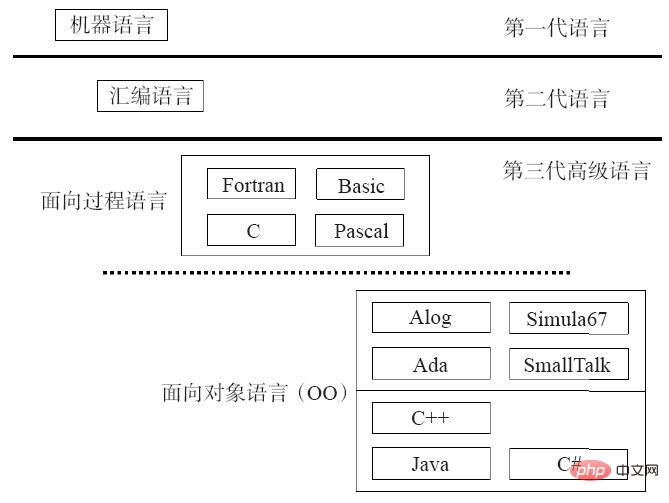
As shown in the figure, the development of computer languages is mainly divided into three stages.

1. Machine language (Recommended learning: web front-end video tutorial)
The first generation of computer language is called machine language. Machine language is 0/1 code. Computers can only recognize 0 and 1. Inside the computer, whether it is a movie, a song, or a picture, what is ultimately saved is 0/1 code, because the CPU can only execute 0/1 code. So does this mean that we must use 0/1 code when programming?
It is definitely possible to write like this at first, but it is too troublesome and difficult to understand, so later assembly language appeared.
2. Assembly language
Assembly language is to convert a string of boring machine language into an English word. For example:
add 1, 2;
add is an English word, so it seems to have a little meaning, that is, the addition of 1 and 2. This is assembly language.
If written directly in machine language, this is almost impossible to achieve. Because it is too difficult to remember in machine language, and no one can understand it. So later a second language was designed, which translated the 0/1 code into English words. These English words directly corresponded to a series of 0/1 instructions. This is assembly language.
Through specialized software, these English words can be converted into 0/1 code and executed by the computer. This software that specializes in translation is called a compiler.
The correspondence between these English words and their corresponding 0/1 codes, as well as the grammar of the language, were already written in when writing this software. We can convert these into 0/1 code simply through the compiler. This greatly facilitates our programming.
3. High-level language
After assembly language, the third generation language appeared. The third generation language is also called "high-level language". The development of high-level languages is divided into two stages, with 1980 as the dividing line. The former stage belongs to structured languages or process-oriented languages, and the latter stage belongs to object-oriented languages.
What is process-oriented and what is object-oriented? This is a difficult question to explain, so don’t think about it now. You won't be able to understand it until you finish learning C language, C, Java or C# in the future. Because this requires comparison.
In short, the most classic and important process-oriented language is C language. Fortran, Basic, and Pascal are largely unused languages. But C language has always been used, because C language is the most important language in the computer field. But C language also has flaws, and its flaws can only be realized after learning an object-oriented language.
So since the 1980s, another "object-oriented" language has been produced, the most important and complex of which is C. C has upgraded the C language in terms of ease of use and security. C is a more complex and difficult language to learn, but very useful once learned.
Because C was too complex, C was later modified, resulting in two languages, one is Java and the other is C#.
The Java language is one of the most popular languages today. C# is a language similar to Java's syntax written by Microsoft in response to the popularity of Java. Since Java and C# are almost identical, you only need to learn one of the languages.
The above is the detailed content of The development of programming languages has gone through three stages. For more information, please follow other related articles on the PHP Chinese website!